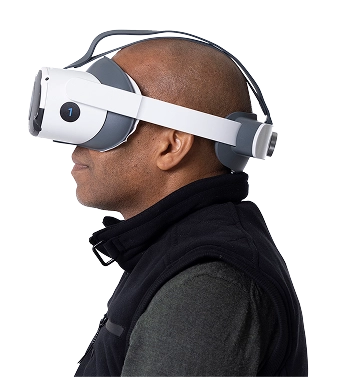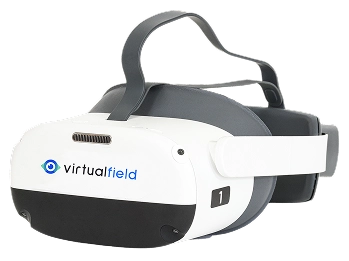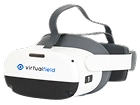Color blindness can alter a patient’s perception of the world. The D-15 color vision test is a proven color blindness screening tool that reveals both red-green and blue-yellow deficiencies by asking patients to arrange color samples in natural sequence. The test is simple, portable, and powerful—offering nuanced results that can inform diagnoses and treatment.
As an extended color vision test, the D-15 is billable to insurance because it reveals more insight than basic screening tools. Learn when the D-15 is recommended, the range of diagnoses it can support, and how you can incorporate this test into your practice.
What Is the D-15 Color Vision Test? Overview of a Color Blindness Screening Tool
First introduced in 1947, the D-15 color vision test, also known as the Farnsworth D-15 test, assesses the severity of a patient’s color vision deficiency. Arranging fifteen colored discs from darkest to lightest, moving from the blue end of the spectrum to red, will reveal subtle differences in perceived color. Despite its simplicity, this can be a revealing test. You can identify protanopia, deuteranopia, and tritanopia, and score these on severity.
Once the patient has arranged the color samples, you can score their accuracy using a circular map. Patients with normal color vision will be able to put the discs in order. Mild blindness will appear as slight deviations from the circle, while more severe color deficiencies will appear as zigzags across the map.
When using traditional, physical discs, you’ll need perfect lighting. Fluorescent overhead lights, inconsistent illumination, or dim bulbs can skew patients’ color vision. Therefore, many Farnsworth D-15 kits come with lighting or special standardizing glasses.
Academic references and clinical validation
Color vision tends to deteriorate with age, and in this study of older adults, both the Farnsworth D-15 test and Adams desaturated D-15 were shown to help identify blue-yellow defects.
Research indicates that factors such as time limitations and the brightness or quality of the lighting will significantly impact D-15 test results when administered using physical colored discs.
A 2024 study found that D-15 color vision testing can be reliably performed on digital screens, even when desaturated. This modality dramatically improves accessibility for both patients and providers.
The average Virtual Field customer gets an extra 62 working hours back thanks to the workflow efficiencies from Virtual Field.
.avif)

30 days free.
No strings attached.
We are confident you’ll love Virtual Field just like the 2,000 doctors who have already made the switch.
How the Portable D-15 Color Vision Test Works
The D-15 color vision test is a clinically validated color blindness screening tool used in both occupational and medical settings to assess moderate to severe deficiencies. The D-15 can quickly and effectively assess moderate to severe color deficiencies.
Unlike the well-known Ishihara plates, the D-15 detects both red-green and blue-yellow color vision deficiencies. The test is beneficial for patients who need color vision testing as part of their occupation. However, it doesn’t provide any information about visual acuity, nor does it detect every type of color deficiency. Patients with mild color deficiencies may still need further testing. When using traditional methods, the D-15’s accuracy can be complicated by improper lighting, test familiarity, and the patient’s fine motor skills.
Pros and Cons of Using a Portable Hue Test for Color Blindness
The pros and cons that follow can help guide you toward the ideal scenarios to incorporate this test into your patients' diagnostic assessments.
Pros
Patients with good color vision may enjoy the D-15 test and treat it as a puzzle.
This test is relatively quick to perform, but it can reveal a lot of information about the patient’s color vision.
Numbered color discs make test results easy, efficient, and objective to score.
Unlike other color vision tests, the D-15 is non-verbal and can be administered to patients regardless of literacy level or language barriers.
As a portable and objective color blindness screening tool, it works well in clinical settings, occupational health screenings, and remote care environments.
The D-15 color vision test is billable to insurance.
Cons
Manually manipulating and arranging the color discs can be time-consuming or challenging for patients with limited fine motor skills.
Traditional D-15 testing equipment takes up space in your practice, and the test requires ideal lighting.
The D-15 can identify multiple types of color blindness, but is most effective for moderate to severe deficiencies, which means that mild anomalies can go unnoticed.
Like other color vision exams, this test cannot provide insight into visual acuity, so additional testing is needed for a complete exam.
What Conditions Can the D-15 Color Vision Test Detect?
Protanopia and deuteranopia
Red-green color blindness accounts for the vast majority of color vision deficiency cases. With the D-15 test, you can identify protanopia and deuteranopia and indicate their severity.
Retinal toxicity
Drugs like hydroxychloroquine are known to impact vision and lead to color vision changes. Other toxins, like chemical exposure and heavy metals, can also cause color vision disturbances that may be noticeable with the D-15 test.

8%
Color blindness affects about 1 in 12 men in America
0.5%
Color blindness affects about 1 in 200 women in America
Tritanopia
Blue-yellow color vision deficiency is much rarer, and you can use the D-15 to identify, map, and measure the severity of this uncommon condition.
Optic neuritis
Optic neuritis can cause color vision deficits, especially red desaturation. Because the D-15 asks patients to arrange colors from blue to red, these anomalies become clearer.
Other Conditions
The D-15 portable hue test can also be used to monitor or diagnose:
• Retinal vein/artery occlusion, retinal detachment and later-stage retinitis pigmentosa
• Glaucoma that impacts blue-yellow color vision
• Autoimmune and inflammatory disorders
30 days free.
No strings attached.
We are confident you’ll love Virtual Field just like the 2,000 doctors who have already made the switch.

Color Vision Testing Device Cost: D-15 Color Vision Test Pricing
Traditional disc-based kits remain the lowest-barrier method for running a D-15. A standard Farnsworth D-15 set costs about $195, while the desaturated Lanthony D-15 — used when you need to pick up subtler blue-yellow defects — runs a little higher at around $209.
If you want a more streamlined experience and faster setup, magnetic versions add convenience but increase cost. The Magnetic Lanthony D-15 kit lists for roughly $250, while individual replacement chips for magnetic Farnsworth sets start at $17 each. All of these costs are one-time capital purchases. It's important to note that over time, you may incur occasional costs to replace faded chips.
Digital solutions represent higher costs but greater modernity. For example, the Waggoner Computerized D-15 is delivered as software for a PC or tablet at $44.99 per month. Portable tablet testers, such as the ColorCheck Hand-held Tablet, cost around $173 for the entire unit and include pediatric LEA symbol options.
Billing, CPT Code, and Reimbursement for the D-15 Color Vision Test
The D-15 color vision test, as an extended and billable color blindness screening tool, qualifies under CPT 92283, as it is considered an extended color vision examination. This code is used for more rigorous exams than the basic color screening included in routine exams, which are not individually billable.
In the United States, this code is reimbursable under the Medicare Physician Fee Schedule (MPFS). The average allowable fee is $57, but your location, setting, and other practice factors will impact this amount.
When is the D-15 color vision test required?
Patients with normal color vision will only need to take the D-15 once. If a patient fails the Ishihara color vision test, the Farnsworth D-15 can provide more conclusive results. Patients with acquired color vision defects may need to take this exam periodically to monitor changes in their vision.
People in certain professional occupations, such as pilots and air traffic controllers, are often required to pass color vision tests. If these patients fail the Ishihara test, the D-15 can be administered as a secondary exam. Signal workers, electricians, police, and certain military personnel may also require the D-15 as part of their profession.
Is the D-15 test required for driver’s licenses?
Regular driver’s license requirements vary from state to state, but most focus on visual acuity and visual field tests. Color vision is only required in Massachusetts and Hawaii, but no states explicitly mandate the use of the D-15. Color vision may be required for commercial driver’s licenses, but they do not explicitly require the D-15 test — an Ishihara test or a similar one is usually sufficient.
Complete Your Comprehensive Exams with Virtual Field
The D-15 test depends heavily on the environment and the patients’ abilities. Patients will not be able to participate in a traditional D-15 test without physically moving the discs into their correct positions, and you will be required to ensure each one is in good condition. And of course, lighting has to be ideal.
Virtual Field’s visual field tests can provide more insight and help monitor disease progression. You can add Virtual Field to your testing routines for comprehensive, precise, and patient-friendly eye exam experiences on a larger scale.
Want all 23 exam guides in one place?
Download our comprehensive guide for 160+ pages of insights.
FAQs
1. What color defects can the D-15 hue test identify that Ishihara cannot?
2. Which CPT code covers a D-15 test?
3. Can D-15 results monitor Plaquenil toxicity?
4. Why doesn't Virtual Field offer a D-15 Color Vision Hue Test?
Ready to get started?
Schedule a demo or begin your 30-day free trial of Virtual Field to try our EOM exam in your practice.

Questions? Contact sales@virtualfield.io to talk to a Virtual Field expert today.


